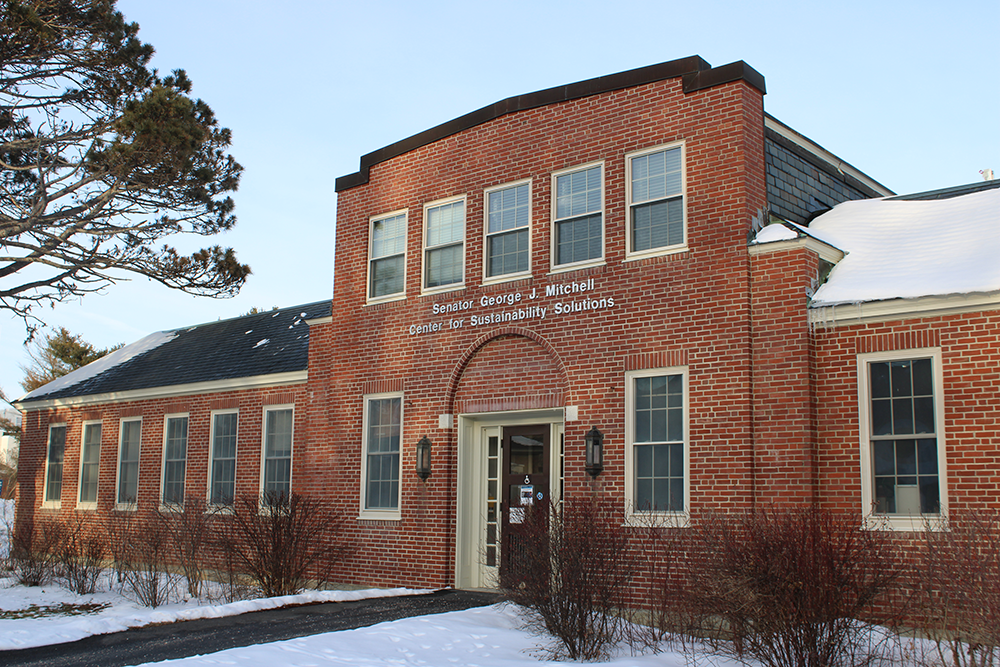Tribal historian James Eric Francis Sr. held a talk on Feb. 27 at the Mitchell Center titled “Penobscot Sense of Place: an Exploration of Indigenous landscapes in the Dawnland.”
Francis is the Penobscot Nation’s Director of the Office of Cultural and Historic Preservation as well as chair of the Penobscot Tribal Rights and Resource Protection board. His primary field of study is the relationship between Maine Native Americans and the landscape.
Francis began his presentation by describing to the audience his personal connection to the song “Goodbye Yellow Brick Road” by Elton John. Listening to it transports him back to the time he traveled in a small panel truck with his mother and siblings at about four years old, he said.
The song came on as they crossed Tobin Bridge in the nighttime. Even now he can visualize the skyline of Boston. After taking Route 1, followed by I-95, they finally made their way to Indian Island to live with his grandmother. Francis considers that to be the first time he ever went home.
“This little island in the Penobscot River has defined who I am,” Francis said.
Francis then went on to mention the embedded irony within the name of the panel van that he and his family travelled north in. It was called Mayflower Moving Van and it brought them to an Indigenous reservation.
After a childhood in Old Town, Francis joined the Air Force because he was intrigued by airplanes and was then stationed in Cheyenne, Wyoming. It turned out to be a missile base known as the “home of the peacekeeper.”
The trees there were few and far between, planted by the cavalry, which caused Francis to feel homesick for the Maine landscape. He traveled back home to his grandmother, the woman he attributes much of his success to.
“On her deathbed, she had told me that I’d been given a gift and that I needed to find a way to give it back,” Francis said.
After careful consideration about what his grandmother could have meant by “gift,” Francis realized she was referring to when he knocked on the door of an elder at the age of 10 years old and asked her what her “Wounded Knee” sign meant.
The elder not only explained the meaning but further fostered his desire for wanting to know history by teaching him language and stories over the following years.
Francis went on to take Native American studies classes at UMaine. He learned about the forcible removal of the Cherokee Nation from their homeland to a foreign landscape, known as the Trail of Tears. Similarly, he discovered that each tribe possessed generations upon generations of knowledge of their homeland.
Henry David Thoreau was an American naturalist and his assistant, Joseph Attean, is Francis’ favorite Penobscot political figure. He was the first elected political chief of the Penobscot Nation and in turn, considered the last hereditary chief.
Joseph Attean died a hero in Maine history at a place called Grand Pitch, which is in the West Branch Penobscot River. Upon an exhibition, his group entered a gorge in the river that was supposed to be avoided on account of the dangerous falls. An elderly man made the fatally unfortunate mistake of knocking the boat due to inexperience. Attean was the only one to die from it.
The next assistant to Francis, Joe Polis, had volumes of writing regarding the birds, flowers, and streams of the Indigenous land. They were later published as journals.
“It was a new light when my guides gave me Indian names for things which I only had scientific ones before. In proportion as I understand the language, I saw them from a new point of view,” Polis said.
Francis elaborated on how vital it is for a communal interpretation of what Indian place names tell us about the region. There is a certain predictability to language through an understanding of its culture. Despite the displacement and distortion that countless tribes have faced, their culture continues to define the land upon which we reside.
Katahdin, which translates to “greatest mountain,” is the largest mountain in Maine. It is important to remember that it was here before our state and that Mount Washington is right off the border.
Gluskabe, the subject of many oral stories, would paddle north in his canoe to reside there with his family and make arrowheads. Upon visiting it, Francis truly understood what the Penobscot tribe meant by “greatest.”
“When I stood on this mountain, I could feel it. There’s an energy, a reverence; there is something about this mountain that no other mountain could do,” Francis said.
Some place names are based on natural resources, such as Hemlock Island and Birch Stream. Others revolve around a specific task or reference legends related to the landscape that reinforce these names. Gut Island was known for being one of the best fisheries. Such prominent geographic descriptions provide a roadmap to migrators.
Francis organized a 13-moon project. He made 13 drums, painted them and conducted a study of the environment. The moons represent nature in different time periods, with occurrences such as ice forming on the margins of lakes, owls and eagles laying their eggs and other portrayals.
“These old names are the colored curtains which hang beside the windows through which we look back into the beginnings of human living here,” Fannie Hardy Eckstorm wrote in her 1943 book on Indigenous place names on the coast of Maine.
Francis delivered the talk several years ago and can be found on Youtube. For more information on the Mitchell Center Sustainability Talks, visit their webpage.








